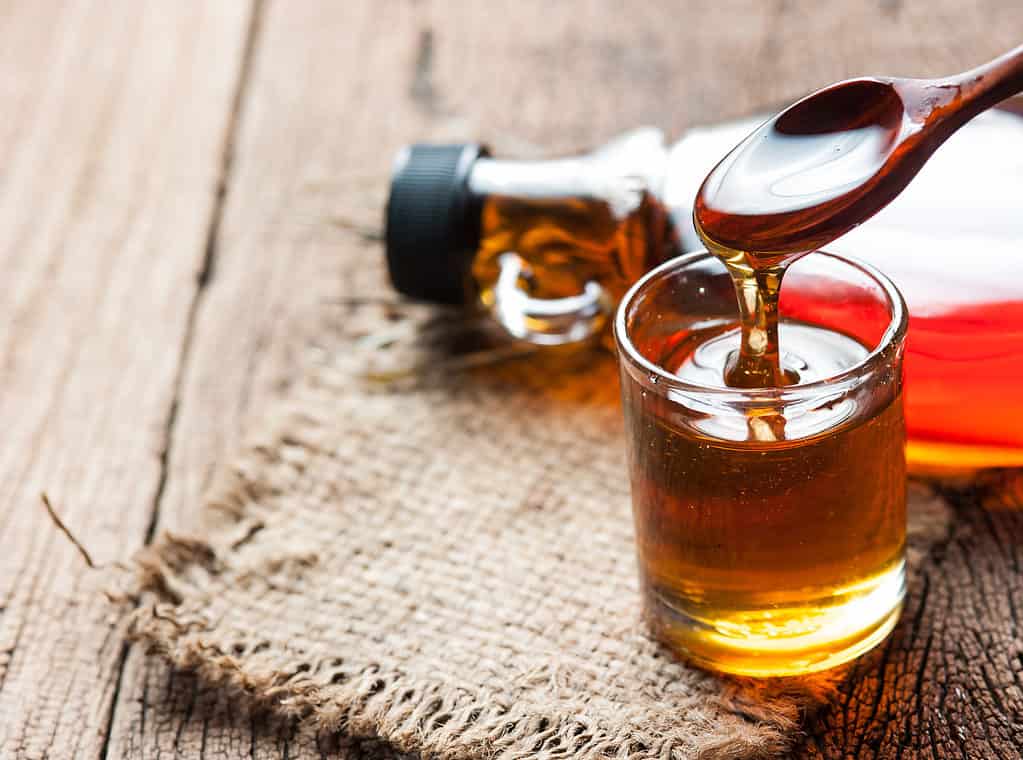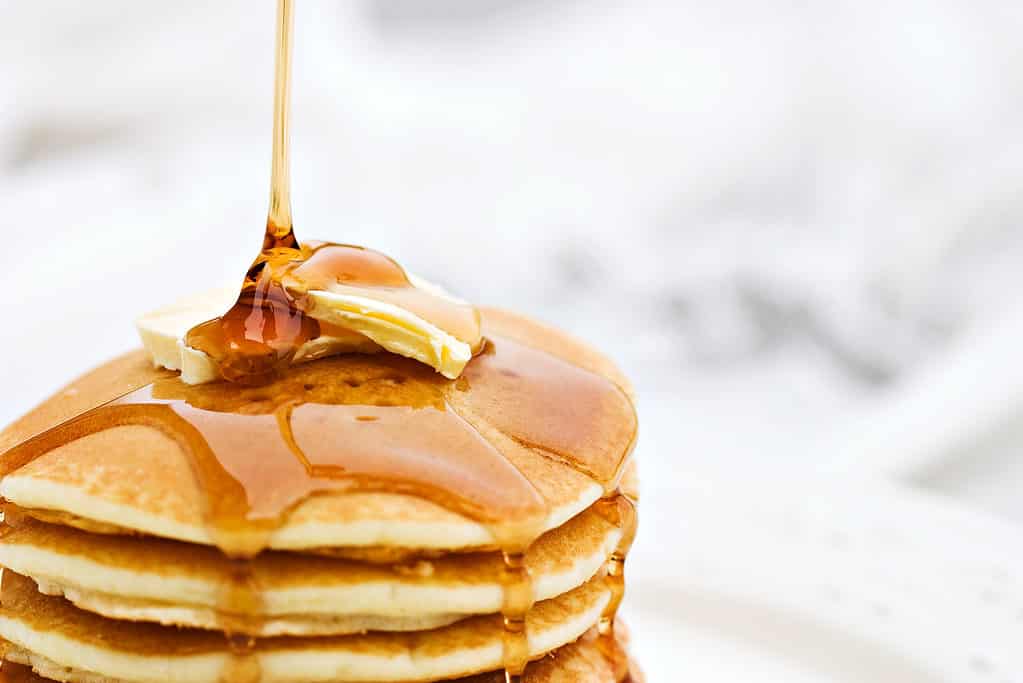Maple syrup conjures up images of sweet, gooey pancakes, and you aren’t the only one drooling because Rover can smell maple syrup in his sleep! Maple syrup is just fine for humans to indulge in, but can dogs eat maple syrup too, and if so, what’s a safe amount?
Let’s uncover whether maple syrup is a safe dog treat or not.
Is Maple Syrup Safe For Dogs?
Natural or pure maple syrup is okay for dogs in small amounts, but the problems start when dogs are fed imitation maple syrup that contains xylitol or other artificial sweeteners. Xylitol is toxic to dogs and has caused fatalities, so it’s really important to check for this ingredient first.
Dogs can eat natural or pure maple syrup, but the bigger question is, should they? Just because a dog can eat something it doesn’t mean they should have it. Although maple syrup contains essential zinc and manganese, it’s also packed with sugar, and sugar has devastating effects on a dog’s waistline and dental health.
We’ll look a little closer look at the pros and cons below, but before we go anything further, just what is maple syrup anyway?

Considered one of the tallest maple tree varieties, sugar maples are one of the main maple trees responsible for maple syrup.
©Mircea Costina/Shutterstock.com
What Is Maple Syrup?
Maple syrup is maple tree sap. It’s extracted from living maple trees via a tap that’s drilled into the trunk. Sap flowing from the opened tap is collected, dehydrated so it’s concentrated, and sold as maple syrup. The concentration process takes it from 2% sugar content to a whopping 66%. You can see where this is going in terms of health!
Sap is a starch that’s converted into sugars during springtime. It was first collected by indigenous North Americans who taught the newbie settlers. Most maple syrup is produced in Canada, with Quebec responsible for 70% of worldwide production.
The word “syrup” is a late 14th-century name for a thick, sweet liquid. It’s taken from the original “sirop”, which is an Old French word for a sugared drink.
There are many products on the market that imitate maple syrup. They are usually less expensive, but the maple sap content is lower and it’s replaced with other ingredients like artificial sweetener. This is usually the case with syrup named “pancake syrup” or maple syrup that isn’t specifically labeled “pure”.

Pure or natural maple syrup is not harmful to dogs, although if they eat too much it can cause obesity and diabetes.
©iStock.com/showcake
Does Maple Syrup Have Health Benefits?
It’s a plant product, so surely maple syrup has some health benefits in that gooey goodness? Yes, it does!
Although it has barely any vitamins, pure maple syrup is high in minerals and antioxidants. To get the most from it, be sure to use pure maple syrup. Here are some of the elements that make up maple syrup:
| Manganese | One tablespoon of pure maple syrup provides a human with up to 33% of their daily amount of manganese. Manganese is important for strong bones, connective tissues, and sex hormones. |
| Copper | Makes energy and supports brain development. |
| Calcium | Essential for strong bones, teeth, and nails. |
| Zinc | Supports the immune system and enables over 100 enzymes to function. |
| Iron | Essential for red blood cell development. |
| Magnesium | Supports muscle and nerve function. |
| Potassium | Regulates nerve signals, cell fluid, and muscle contractions. |
Antioxidant support
Like many plant extracts, maple syrup is rich in antioxidants that fight oxidative damage. Scientists believe antioxidants are responsible for the aging process and some diseases like cancer, so it’s great to have maple syrup fighting in our corner.
It May Lower Cholesterol
Animal-based studies show maple syrup can possibly help lower cholesterol and it may help prevent Alzheimer’s disease too. Even though these studies are in their infancy, it’s exciting news for humans and their dogs.
The Risks if Your Dog Eats Maple Syrup
Although it contains many nutritional elements, maple syrup is also a sugary health risk. Let’s look a little closer at why too much sugar is a problem for dogs.
Obesity
According to the Association for Pet Obesity Prevention, 56% of pet dogs in the United States are overweight or obese. That’s a large number of our pet dogs who are at an increased risk of diabetes, cancer, joint damage, and pancreatitis.
Too much weight really reduces a dog’s quality of life, and maple syrup on a regular basis can contribute to rapid weight gain.
Dental decay
Sugar causes dental decay in dogs just as it does to us. Cavities, bleeding gums, and exposed nerves are extremely painful. Because they do so much with their mouths, from eating to carrying and playing, a toothache is a truly horrible problem for dogs. This is also a problem for dog owners’ wallets because insurance companies often exclude dental care from their policies.
Diabetes
Diabetes goes paw-in-paw with obesity, and it’s a lifelong disease that requires daily care. A diabetic dog can live a full life, but diabetes is avoidable. Maple syrup is high in sugar, which increases the risk that your dog will get diabetes.
Artificial Syrups
While pure maple syrup is fine for your dog, artificial syrups are not. Always check the label before giving any kind of syrup to your pooch because it may contain a harmful additive like xylitol.
We can eat xylitol, and do so on a regular basis. However, dogs cannot process xylitol and it causes a huge drop in blood sugar that can lead to hypoglycemia. Dogs have died after eating sugar-free chewing gum and skinny ice cream containing xylitol.
Xylitol is used in place of sugar and it pops up in syrups, toothpaste, mouthwash, gummy sweets, cough medicine, Jell-o, cakes, and biscuits. This is why it is so important to always check the ingredients of products before you share them with your dog.

Many store-bought syrups today contain xylitol and artificial sweeteners, which are extremely dangerous to dogs.
©iStock.com/StephanieFrey
My Dog Ate Maple Syrup, What Should I Do?
If Lassie grabbed your dropped pancake with maple syrup topping, don’t panic. The chances are she’ll be just fine. Pure maple syrup won’t hurt your dog in small doses. It may cause an upset stomach, however, so look out for flatulence, diarrhea, or vomiting and give her small portions of plain food like chicken and rice or sweet potato with turkey until the episode is over.
If the syrup contained xylitol (look at the packaging) then it’s more concerning. Monitor your dog for signs of xylitol poisoning, which include excessive panting, drooling, tremors, weakness, and collapse.
It’s best to speak to a vet right away if your dog ate xylitol or anything containing xylitol. Have the packaging on hand if possible because your vet will want to know how much your dog ate and what breed of dog you have. Small dogs are more at risk, but xylitol poisoning can affect all breeds.
How Much Maple Syrup Is Safe for Dogs to Eat?
Pure maple syrup without additives isn’t harmful in small quantities, but what exactly is a small quantity?
The ASPCA recommends that treat-type food make up no more than 10% of a dog’s daily intake and that the remaining 90% come from complete dog food. However, 10% in pure maple syrup will cause rapid weight gain.
As with treat food like peanut butter or cottage cheese, about a spoonful is enough for a large breed and about one-quarter to half a spoonful for smaller breeds. This might sound like nothing at all, but remember dogs are smaller than us and need less.
You can add maple syrup to your dog’s main meal or offer it on a spoon. Spoon feeding is a great way to bond with your dog! If your dog will let you brush their teeth, it’s a good idea to scrub them clean afterward.
Another way to give your dog maple syrup is a little smear inside a puzzle toy. This can help calm anxious dogs and help prevent destructive behavior.
What Foods are Dangerous for Dogs?
Maple syrup without additives won’t hurt your dog, and we know about xylitol’s dangers, but what else can’t dogs eat? Here are a few examples of foods that are dangerous for dogs to eat:
| Grapes | Grapes, raisins, sultanas, and grape juice can all cause liver and kidney failure. |
| Macadamia nuts | Macadamia nuts contain toxins that cause organ failure. |
| Black walnuts | Black walnuts grow a type of mold that is a dog neurotoxin. |
| Chocolate | Chocolate contains stimulants they can’t process, which leads to organ failure. |
| Nutmeg | Its compounds cause hallucinations and painful gastric upsets. |
| Bleu cheese | Roquefortine C mold that creates the blue fungus can cause seizures. |
| Alcohol | Ethanol in alcohol poisons dogs and causes organ failure. |
| Raw dough | Raw dough rises in a dog’s warm belly and releases toxic ethanol. |
| Stone fruits | The pits of peaches, plums, and cherries are toxic enough to cause fatalities. |
Is Maple Syrup Safe for Dogs?
To conclude, pure maple syrup is safe for dogs in small amounts. It contains minerals and antioxidants, and it’s a pleasant eating experience for them — and who doesn’t like a taste of sweetness? However, even natural or pure maple syrup will lead to rapid weight gain, so moderation is key.
However, maple syrup with additives is dangerous to dogs because of the xylitol risk.
There are other dog-friendly treat options containing fewer calories than maple syrup. Offer apple slices, green beans, or bananas instead to maintain a healthy weight.
Up Next:
- Are Pancakes Safe For Dogs To Eat, Actually?
- Yes, Dogs Can Eat Honey. But Read This First
- Can Dogs Eat Sugar?
The photo featured at the top of this post is © iStock.com/showcake
Ready to discover the top 10 cutest dog breeds in the entire world?
How about the fastest dogs, the largest dogs and those that are -- quite frankly -- just the kindest dogs on the planet? Each day, AZ Animals sends out lists just like this to our thousands of email subscribers. And the best part? It's FREE. Join today by entering your email below.
Sources
- Canadian Food Inspection Agency, Available here: https://web.archive.org/web/20111201232833/http://www.inspection.gc.ca/english/fssa/labeti/guide/ch13e.shtml
- Taylor Francis Online: Nutritional Neuroscience, Available here: https://www.tandfonline.com/doi/abs/10.1080/1028415X.2019.1672009
- Spring Link: Nutrition & Metabolism, Available here: https://link.springer.com/article/10.1186/s12986-019-0403-2
- ASPCA: American Society for the Prevention of Cruelty to Animals, Available here: https://www.aspca.org/pet-care/dog-care/dog-nutrition-tips
Thank you for reading! Have some feedback for us? Contact the AZ Animals editorial team.






